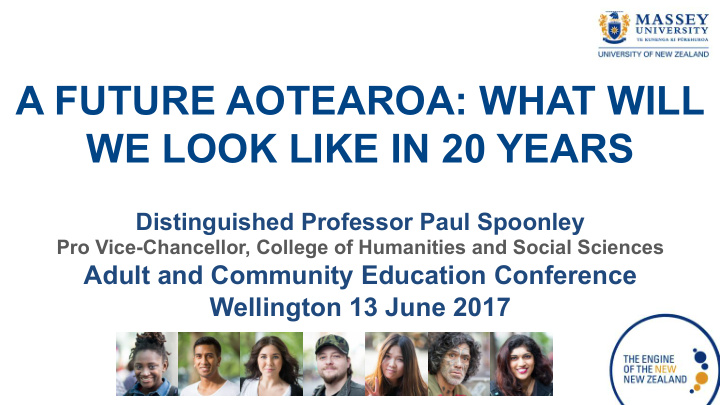



A FUTURE AOTEAROA: WHAT WILL WE LOOK LIKE IN 20 YEARS Distinguished Professor Paul Spoonley Pro Vice-Chancellor, College of Humanities and Social Sciences Adult and Community Education Conference Wellington 13 June 2017
In 10 Years • 2 out of every 5 NZers will live in Auckland • Asian communities will outnumber M ā ori • There will be more people aged over 65 than 0-15 years of age
In 20 Years • More New Zealanders will live in Auckland • Two-thirds of New Zealand’s regions will be smaller and older • New Zealand will be even more ethnically diverse
Factors That Will Change Aotearoa – and Education • Work will be disrupted • Divergent regional growth/decline – and futures • Diversity – and immigration • Generational differences
Work After the Digital Revolution Disruptive technologies CEDA = 40% of all 2015 jobs will have gone over the next two decades (60% in rural areas) and new jobs Divergence in employment: High skilled and low skilled Mid-level jobs seriously impacted Gig economy and precarious employment
BA: New Compulsory Core Ø Turangawaewae: Identity & Belonging in Aotearoa NZ Ø Tu Kupu: Writing and Inquiry Ø Tu Arohae: Critical Thinking Ø Tu Rangaranga: Global Encounters Ø Tu Tira Mai: Practising Engagement
BA: Transferable Skills EMPLOYABILITY AND FLEXIBILITY • Good communication and technology skills • Cultural intelligence • People-to-people skills • Team player • Independent problem solver
Regional Population Stagnation – and Decline • Deaths will outnumber births in 60% of NZs TAs in 2 decades • 47 (out of 67) TAs will have fewer children than in 2013 • 75% of population in North Island and Auckland will see 60% of all population growth
Regional Profiles: Examples Northland Southland New Zealand Demography Fer$lity rate (per 1000) 96 84 79 <15 yrs 21.9% 20.5% 20.2% >65 yrs 19.8% 16.4% 15.5% Net immigra$on 33 362 38,338 Ethnicity Maori 32.4% 13% 15% Asian 2.8% 3.2% 11.8% Socio-Economic Jobless 13.4% 7.5% 8.8% Benefit depending 14.0% 7.8% 7.8% NEET (15-19 yr olds) 12.9% 11.6% 8.1% Offending Apprehension (17-20 yr olds per 1000) 168 178 122 Illicit drug offences (per 10,000) 90.7 34.7 53
Immigration - 2016 • Permanent and long term migrants: 128,300 • Net gain: 71,300 • Auckland: 57,000 immigrants North Island: 87,000 immigrants South Island: 21,300 immigrants
A Future Aotearoa – Hyper-diversity (2013-2038) All 0-14 Yrs European/Pākehā 75% - 66% 71.6% - 68.2% Māori 16% - 18% 25% - 30% Asian 12% - 22% 12% - 21% Pasifika 8% - 10% 13% - 18%
Why Immigrants Are Needed • Population stagnation (now) • ⅔ of NZ’s regions stagnation • Sub-replacement fertility (2020s) • Structural ageing (more 65+ than 0-14 years of age, 2020s)
Net Worth European/P ā keh ā $114,000 Asian $32,000 M ā ori $23,000 Pasifika $12,000 • Younger age profiles • Communal or iwi assets not considered • Regional loca$on
Generational Differences 65+ 0-15 • Home ownership • Housing affordability/ availability? • Careers/employment stability • Precarious work in a gig economy • State pays • NEET • Redundancy/redundant
Concluding Comments … • How do we respond to the size and nature of a primate city vs regional stagnation • How inclusive and responsive are we to diversity? • How do we balance out funding for older vs younger New Zealanders? • How do we prepare New Zealanders for the different world of work?
Recommend
More recommend